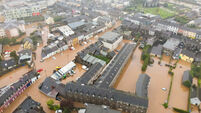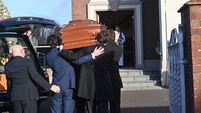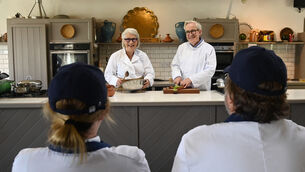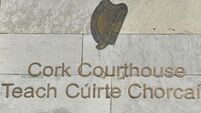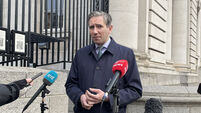De Gaulle in Sneem: What attracted a French president to Kerry?
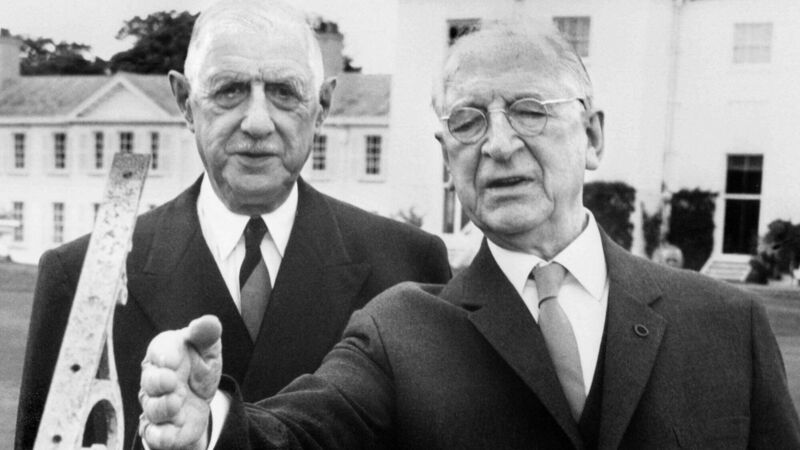
French president Charles de Gaulle (L) speaks with President Eamon de Valera June 18, 1969, during his visit to Ireland. Picture: AFP via Getty Images
A TG4 documentary on the surprise arrival by the just-resigned French president to Ireland 51 years ago reveals how it was more than the tranquil scenery that sparked the choice of location.
Much of focuses on the two weeks Charles De Gaulle and his wife Yvonne spent in Sneem, Co Kerry.
The leader of the Free French and his wife had wanted a bolthole after losing a key referendum. But it was the 1960s and the world had changed. France was entering a period of “mediocrity”, the deeply disappointed conservative general — born in the 19th century — believed.
The Sneem visit — he was greeted in Cork Airport by Jack Lynch — did not remain “caché” for long.
He was broken and bruised, but his location — not just in Ireland, but South Kerry — amazed the world, recounts Grace Neville, Emeritus Professor attached to the French Department in UCC and one of the principal contributors to the documentary.
Prof Neville, for perhaps the first time, explains the mystery of De Gaulle’s choice of south Kerry: This was not just a quiet corner for De Gaulle — it was also the birthplace of Daniel O’Connell, 'the Liberator' — a term De Gaulle used to describe both himself and O’Connell in the visitor’s book in Derryname.
His paternal grandmother, Joséphine, had written a biography of O’Connell which had gone into a third edition.
De Gaulle had wanted to visit the home of O’Connell since a young child, we learn from a relative.
The egalitarian-minded O’Connell, fluent in French, part-educated in France, was accepted as “a member of their tribe” in France and remained a huge figure even decades after his death. Right throughout leading French people visited and stayed with O’Connell and his family in south Kerry, Neville relates.

The visit itself is well recalled. Betty Crosbie, who was at Sunday Mass in Sneem when De Gaulle and his wife arrived and shook hands them, contributes, as does “De Gaulle’s barber” — local man Peter Hanley.
The iconic photograph of De Gaulle at Mass, which appeared on the front of Paris Match, was taken by the late Joan Kennelly, then an agency photographer with her late husband Padraig Kennelly in Tralee — scooping the world’s media.
The makers have also managed to interview Francois Flohic, De Gaulle’s Aide de Camp who accompanied the former general to south Kerry.
Monsieur Flohic reveals how the end of De Gaulle’s political career was also when he began writing his best-selling memoir while staying at the Heron’s Cove Hotel in Sneem. After beginning his memoirs in Kerry, he continued his writing in Cashel House Hotel, Connemara. The large media presence had not followed him, and for the first time he and Madame De Gaulle were able to relax.
The visit concluded with Éamon de Valera at Áras an Uachtaráin, and the remarkable similarity of the two men, both in their lives and their appearance, is underscored.
We learn that De Gaulle would liked to have gone to Loughlinisland to visit the grave of his ancestors, the McCartans, who were forced to flee Co Down after the Battle of the Boyne. But in 1969, some 300 years later, another conflict was kicking off and De Gaulle never got to see it.
With strong contributions also from Dr Eamon O Cíosáin of the French Department at Maynooth, a Chevalier dans l’Ordre des Palmes Académiques, and narrated by Doireann Ní Bhriain, will air on TG4 on Wednesday November 11, at 9.30pm. It is produced by Tile Films for TG4. Charles de Gaulle's anniversary is on November 9.





